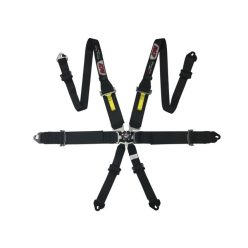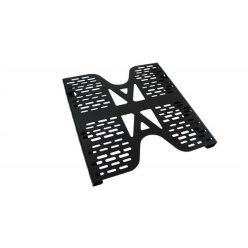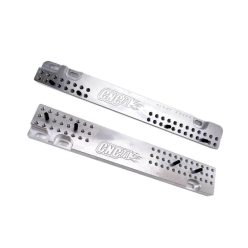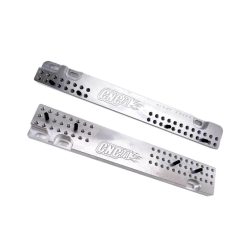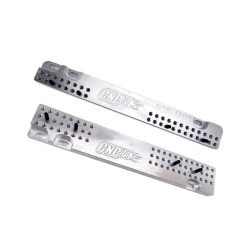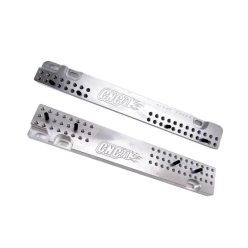Our Safety Harnesses & Accessories cover 4/5/6-point belts, hardware and mounts for road and track use. Choose FIA or SFI-approved options, check the homologation label and the intended mounting method (clip-in/bolt-in/wrap). Pair the harness with the correct seat brackets and anchors to maximise safety, comfort and compliance.
Brief Summary & Key Benefits
The Safety Harnesses & Accessories range covers solutions from spirited track days to serious club racing. Modern 4/5/6-point systems distribute loads across shoulders, pelvis and the anti-sub strap to keep the driver planted under braking and impacts. High-strength webbing, precise adjusters and reliable buckles (camlock or push-button) enable quick operation while maintaining restraint. Matching seat brackets, eye bolts, backing plates and mounts complete a robust and compliant installation path.
Technical Basics
Common webbing widths are 2" (50 mm) and 3" (76 mm). Two-inch shoulder straps improve compatibility with HANS devices, while three-inch variants spread pressure for comfort without HANS. Materials are high-tenacity polyester; FIA and SFI approval indicates test standards and expiry. Buckles come as camlock rotary releases or push-button types; camlocks dominate in motorsport for speed and ergonomics.
Mounting methods include clip-in, bolt-in and wrap onto a harness bar or seat frame. Chassis attachment typically uses eye bolts with adequate backing plates to spread loads. Keep the homologation label intact and readable; it lists standard, manufacturer and expiry date required by scrutineering. Frequent pitfalls are incorrect shoulder strap angles, sharp-edged routing, undersized hardware or poor thread engagement.
Ideal geometry: shoulders run rearward at roughly –10° to –45° from the seat pass-throughs; lap belts sit across the iliac crest (pelvis), not the abdomen; the anti-sub strap routes between the legs at the prescribed angle to prevent submarining. Hardware grades should match specification (e.g., class 8.8/10.9), and washers must provide proper load distribution.
Selection Criteria
First, define usage: road-legal track days or competition. For competition, insist on valid FIA/SFI approval and check the expiry year. Choose webbing width to suit HANS use; 2" shoulders are generally preferred with head-and-neck restraints. Next, select the mounting method: clip-in favours easy removal, bolt-in gives a fixed solution, and wrap works neatly with a harness bar. Ensure your seat type (side-mount or base-mount) is supported by the correct brackets and spacers.
Comfort and operation matter: smooth-running adjusters, clear length markings and padded shoulders help multi-driver cars. For colours, high-contrast webbing makes scrutineering and label checks easier. Verify that anchor points are positioned correctly in your chassis; consult manufacturer diagrams and, if needed, a professional installer.
Installation & Maintenance
Follow the maker’s torque specs and angle diagrams. Use suitable backing plates and treat bare metal for corrosion protection. Avoid routing over sharp edges; add edge guards where necessary. Apply threadlocker only when specified and secure snap hooks with retaining clips. After installation, sit in the car, tighten lap belts first, then shoulders, and finally the anti-sub to achieve firm but comfortable restraint.
Before each session, inspect for wear, fraying, damaged stitching and buckle function. Clean webbing with mild soap and water; avoid solvents and heat. Replace any harness with damage, severe UV exposure or an expired homologation label. Store away from direct sunlight to slow ageing. Proper care preserves performance and compliance throughout the season.
FAQ
Q: Are 4/5/6-point harnesses legal on the road?
A: It depends on local laws and vehicle approval. Many regions require the original seat belt for road use; use the harness primarily for track.
Q: 2" vs 3" shoulders—what should I choose?
A: 2" works best with HANS, while 3" may feel more comfortable without it. Match to your restraint system and seat.
Q: Which mounting style is best?
A: Clip-in for frequent removal, bolt-in for fixed installs, wrap for harness bars—always follow the manufacturer’s guide.
Q: How long is an FIA harness valid?
A: Until the expiry date shown on the label; expired belts are not permitted in competition.
Q: How tight should the belts be?
A: Tighten lap belts first across the pelvis, then shoulders; the driver should be secure yet able to breathe and operate controls comfortably.


